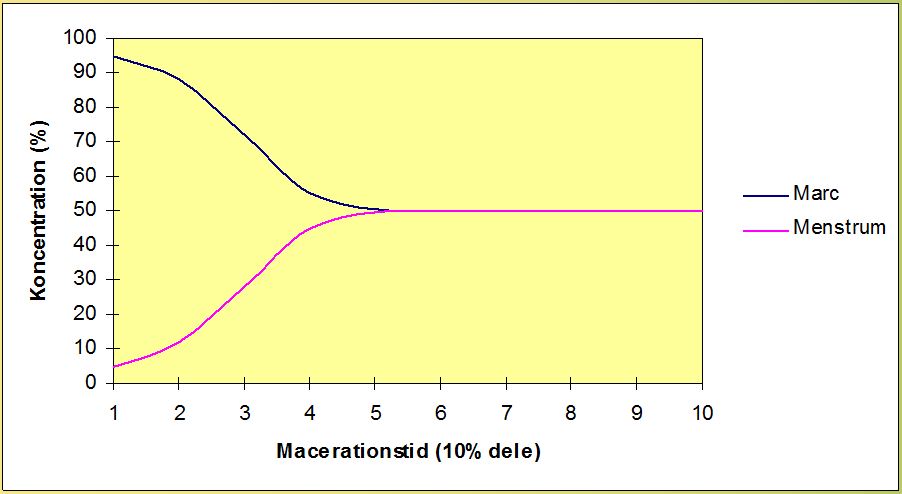|
Asclepius Herbal
Consultancy
Production Methods
Percolation
contra maceration;
the art of capturing nature in a bottle
Many Phytopharmaceutical companies utilise either maceration or
cold-percolation systems in the production of herbal extracts. The
percolation method has many qualitative advantages over simple
maceration, which is probably the most commonly used herbal extract
production technique.
Both maceration and percolation rely primarily on the diffusion of
the relatively high concentration of constituents in the herbal
material into the extraction medium; containing a relatively lower
concentration of constituents. However, there is also a rinsing
effect involved in the extraction process, whereby the extractive
substances from destroyed cells in the herbal material being
processed are simply washed out, either by the movement of
extraction medium through the herbal material, as is the case with
percolation, or by regular agitation of herbal material undergoing
maceration.
Percolation
The
percolation process provides the best scenario for ensuring an
optimal degree of both diffusion and rinsing. During percolation,
the herbal material is constantly exposed to a virgin extraction
medium, thus ensuring that the highest possible diffusion gradient
is maintained throughout the whole process between the herbal
material under extraction and the extraction medium until exhaustion
of the plant material is ultimately achieved.

When carried out
effectively percolation can extract a much higher percentage of the
constituent substances contained in the herb compared to other
commonly used extraction methods.
Maceration
During a maceration process however, the diffusion gradient
decreases as the concentration of constituent substances rises in
the extraction medium, and diffusion ultimately stops when there is
an equal concentration of constituent substances in both the herbal
material and the produced extract.

Preperation
Nomenclature
From this it can be seen that the
ratio nomenclature, which is often used to describe the ratio of
herbal drug to extraction medium in a herbal preparation, is a
rather misleading guideline regarding extract strength. In principle
a 1:3 macerated extract could contain up to 50% less of the
constituent substances than an effectively produced 1:3 percolation.
From an economical point of view percolation would appear to provide
the best value in terms of raw material investment. In common
production practice however, maceration and variations of the
maceration process are often employed as they are simpler and less
time consuming processes compared to the percolation method; even
though at least 50% of the herbal constituents are ultimately thrown
away in the wasted herbal material.
Discussion
The difficulties encountered
with percolation lie in the complex control parameters inherent to
the percolation process. Many factors have to be taken into account
when using the percolation method and the production practice
requires a relatively high level of operator skill and experience;
to ensure correct packing of the percolator in order to prevent
clogging of the system and to adjust for the correct percolation
rate (velocity).
In
order to compensate for these process-related factors and to ease
the production process, many producers compromise the percolation
process in order to increase the functionality of the percolation
apparatus. An example would be the funnel-formed percolator, where
the percolation process occurs in a conically tapered system. This
system has the advantage of been easier to pack. Unfortunately
however, it suffers a major drawback. Due to the form of the system
there is not a linear (lamina) flow of extraction medium through the
system. The Weber effect of the funnel form causes an increase in
percolation velocity through the system and Bernoulli’s principle
dictates that this would increase turbulence in the extraction
medium causing an increase in non-linear flow towards the funnel
apex. As percolation relies primarily on diffusion it is important
to reduce turbulence to a minimum and promote a lamina flow of the
extraction medium through the herbal material.
Yet
another parameter which is difficult to control in currently used
percolation systems is the percolation velocity. There are many
factors which influence percolation velocity: packing density of the
herbal material, head-pressure of the extraction medium and the
diameter of the exit from the system. A skilled operator has
experience in packing the specific herbal material and knows how
tight the material should be stamped to ensure a packing density
that facilitates for a reasonable flow velocity. Finally, during the
percolation process the operator has to constantly monitor and
adjust the exit valve in order to control the flow velocity and
compensate for variations in the head-pressure (which falls in a
non-linear fashion in funnel-formed percolation systems).
Asclepius Herbal Consultancy has developed an automated computer controlled
Percolation System (VCLF), which eliminates many of the difficulties
encountered with the percolation process.

|